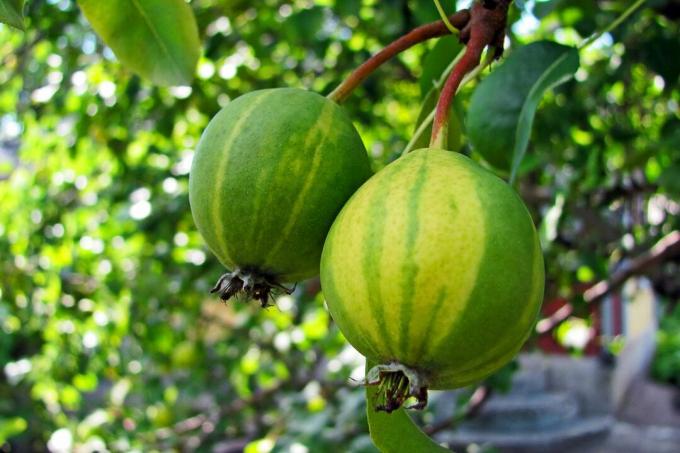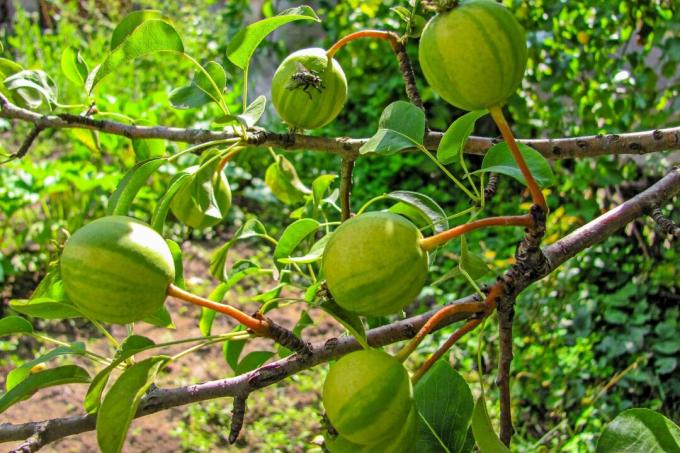The pear variety 'Schweizerhose' is often referred to as a lover's variety. We will tell you why and what you can do with this special pear.

The first thing that catches the eye of the 'Schweizerhose' pear is its striped skin. Due to its appearance, it is particularly popular as a decorative bulb. This variety is less likely to be found in commercial crops or on supermarket displays. Because of its robustness and the high ornamental value, the variety is suitable as an eye-catcher for the home garden.
contents
- Pear 'Swiss trousers': profile
- Swiss trousers: history and origin
- Appearance, taste and properties of the 'Swiss trousers' pear
- Schweizerhose pear: cultivation and care
- Harvesting and Using the Swiss Pants
Pear 'Swiss trousers': profile
| synonyms | Early Melon Pear, Cucumber Pear, Swiss Bergamot |
| fruit | Medium-sized; yellow, green and red stripes |
| the taste | Moderately good, juicy and sweet |
| yield | Medium high, swaying |
| harvest time | From September |
| maturity | late October to November |
| shelf life | Until the end of December |
| growth | Initially strong, later medium strong |
| climate | Broadly cultivable, warm locations improve fruit quality |
| diseases and pests | Not known |
Swiss trousers: history and origin
The 'Swiss trousers' were already mentioned several times in Switzerland around 1800 and it is assumed that their origins go back to the 17th century. century. Various assumptions say that this variety is already around 400 years old and that it is a mutation of the 'Long Autumn Pear' from France. Different stripes can also appear in other pear varieties due to mutation, but these often disappear again due to reverse mutation - but not in the 'Swiss trousers'. Their special name 'Swiss trousers' comes from the also striped trousers of the Swiss Guard in the Vatican. The 'Swiss Pants' variety, which has become rare, has been propagated from a few trees again in the last decade with state funds. As a result, it is now becoming increasingly available and was even voted pear variety of the year in Switzerland in 2011.

Appearance, taste and properties of the 'Swiss trousers' pear
The most striking thing about the 'Swiss trousers' pear is certainly its fruit. These are small to medium-sized and bulbous. Their shell, which is actually light green, has yellow-green or red vertical stripes. These stripes run from the stem to the calyx. In addition, fine shell points are visible. The flesh is very fine-celled and juicy. The taste of the 'Swiss trousers' is rated as only good enough by gourmets - with this fruit the appearance is more important than the taste. Due to the striking stripes and the shell dots, the 'Swiss trousers' pear is a popular decoration in the house and is not eaten directly as a table pear. The ornamental value is therefore in the foreground with this variety.
Tip: Not only the fruit, but also the young wood of the 'Swiss trousers' is striped lengthwise.
Schweizerhose pear: cultivation and care
The growth of the 'Swiss pants' tree is initially strong, later only medium strong. A rather medium-sized and moderately branched crown with thin shoots forms here. Regular pruning when young is necessary for the crown to build up. Older trees may need a heavier pruning of the crown.
The 'Swiss trousers' pear is undemanding and resilient when it comes to its location. It can be grown up to medium altitudes, but here it needs a wind-protected location. However, if the 'Swiss trousers' are grown in milder or warmer locations, this has a positive effect on the taste of the fruit. This can then also be sweeter and more aromatic than in cooler locations. This variety also has no special requirements for the soil and can therefore be grown on normal as well as loamy or sandy soils.

The half-stem and high-stem are the most common forms of training for the 'Swiss trousers' pear. It is also suitable for the garden in a trellis or as a bush tree. By grafting on rather slow-growing rootstocks such as 'Pyrodwarf®', the cultivation of 'Swiss trousers' is then also possible in smaller gardens. It also proves feasible to use quince as a rootstock, for example the slow-growing quince C.
Between April and May, the white flowers of the 'Swiss trousers' pear can be seen. Pollinators include the 'Williams Christ', 'Conference' and 'Clapp's darling' in question. The yields of the 'Swiss trousers' are medium and fluctuate from year to year.
The 'Schweizerhose' pear is usually not affected by pests or diseases, as the variety is considered to be very robust or at least no susceptibility is known.
Harvesting and Using the Swiss Pants
The 'Schweizerhose' pear is an autumn pear and reaches maturity between September and October. The fruits are sessile until shortly before harvest, but then fall and should therefore be harvested in good time. After harvesting, the pears can be kept for several weeks - but the pears taste best straight from the tree. If you don't want to eat the 'Swiss trousers' pear directly, you can also process it into juice or use it as a nice decoration.
As you do in your garden Plant a pear tree and you can find out from us what needs to be taken into account.
